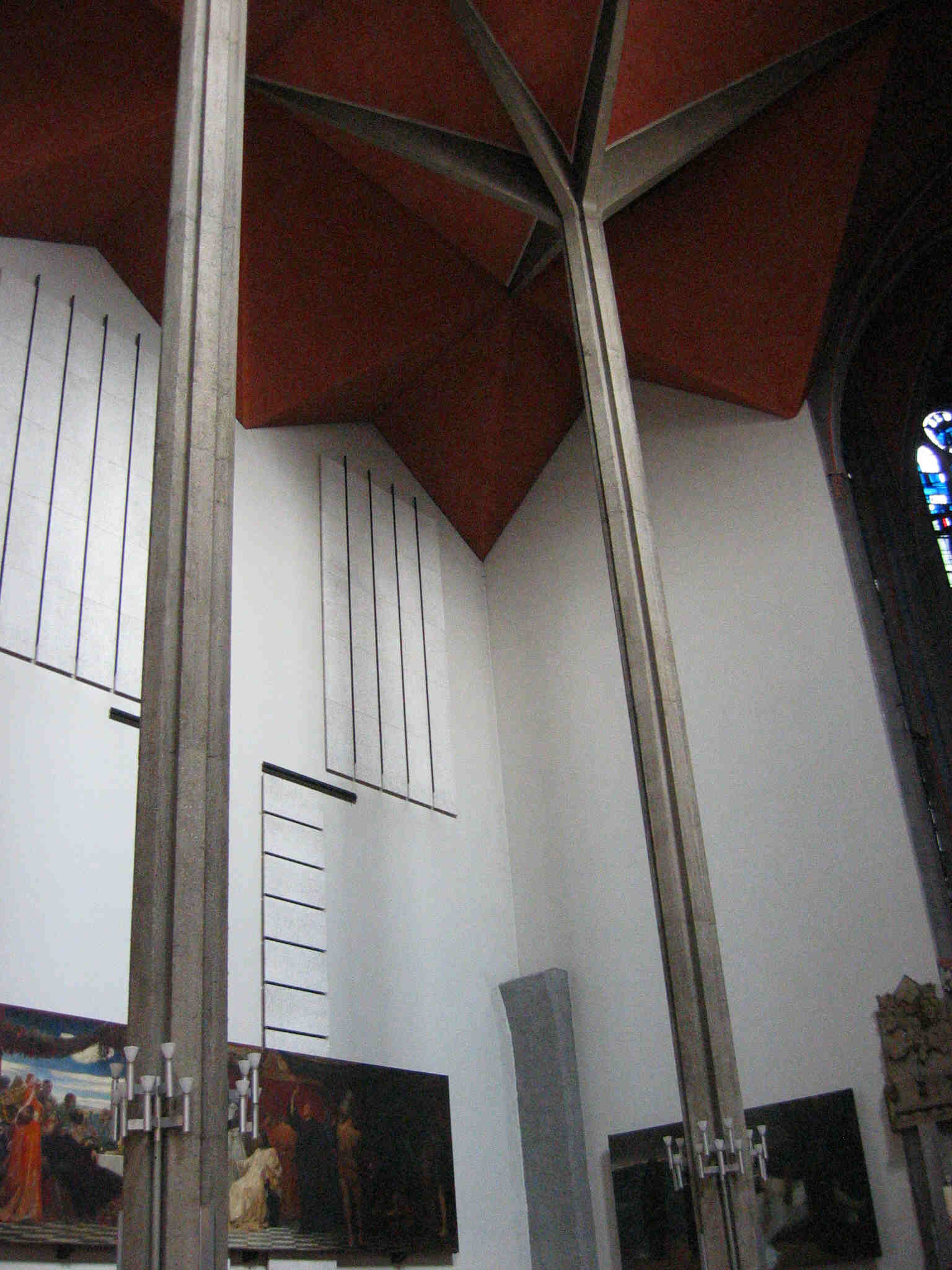CATHEDRAL QUEST
Our quest to experience the great cathedrals and churches of Europe
Day 3 Thursday, May 24
Cologne (Koln) to Aachen
We
had another wonderful breakfast in the hotel dining room.
We headed across the street to buy a train ticket for Aachen.
We weren’t sure how to use the ticket machines so we went to the train
ticket office. Our ticket turned out
to be a special round trip ticket for up to five people.
We discovered this late in the game.
We kept
looking at the ticket to find which “class” we were.
On the way to Aachen, a conductor told us to sit in first class, and we
didn’t object. Another
conductor told us we were in the wrong place but didn’t move us.
It was a dome car.
When we arrived in Aachen, we tried to find a map without any luck so we just followed some of the crowds to the cathedral.
AACHEN CATHEDRAL
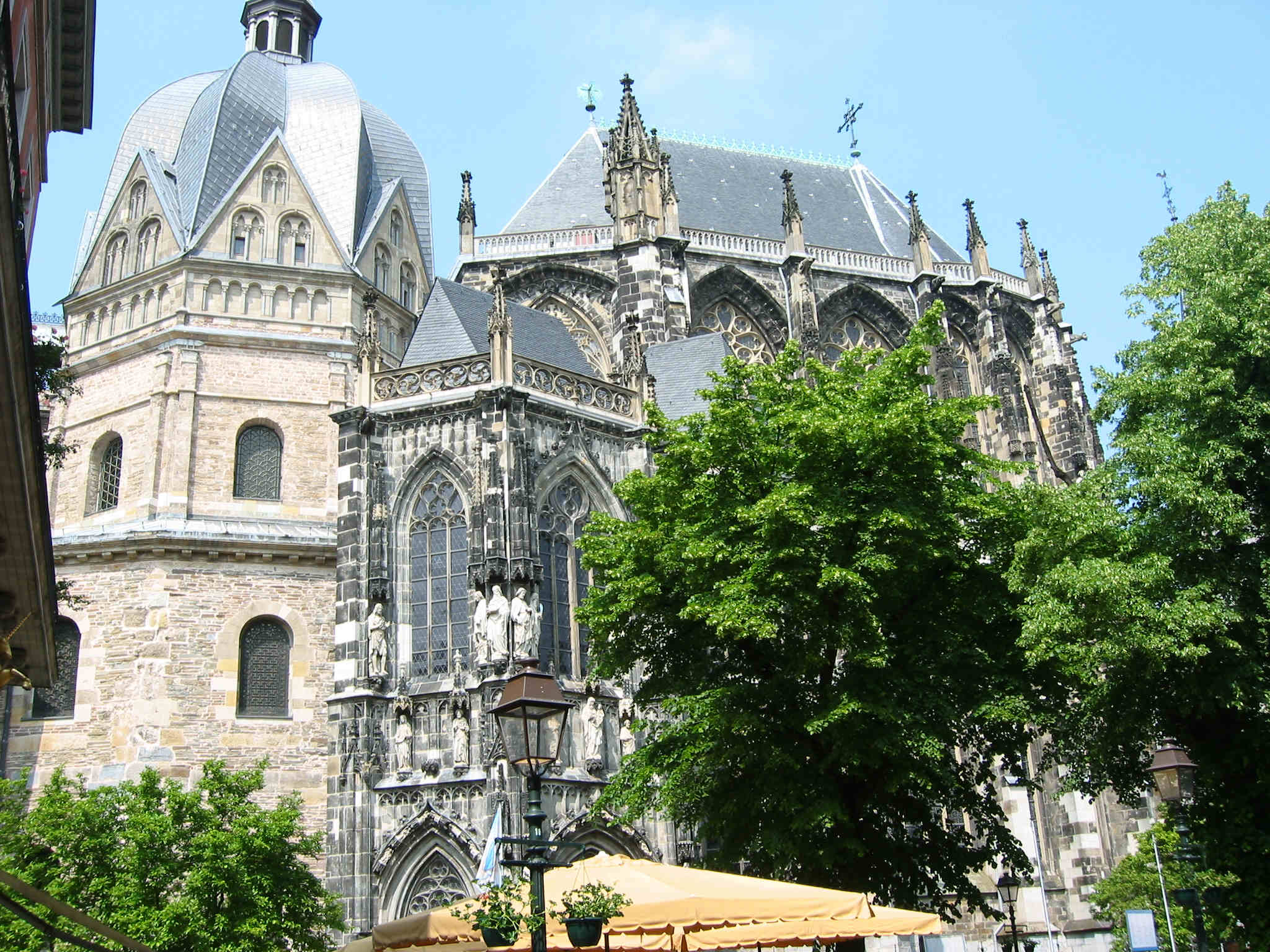
On
Christmas Day in the year 800 A.D Pope Leo III placed the imperial crown on the
head of Charlemagne and established the Holy Roman Empire.
Charlemagne decided to live in Aachen in Germany, not far from Cologne.
As a Christian ruler he would not have taken up a permanent residence in
Aachen without building a church.
In
800, the first domed chapel church was built beyond the Alps. For
the dome, Charlemagne built an octagon rather than a rotunda.
The octagon was a sign of perfection.
It is somewhere between a circle and a square.
The circle without beginning or end symbolizes the eternity of heaven,
and the square the four corners of the earth.

The
length, width and height of Charlemagne’s
Palace chapel are all equal. The
octagon is surrounded by a 16 side polygon.
There
are eight massive pillars, folded into each other making double pillar.
Each pair are close together so to carry the weight of the whole
building. Above these pillar are
slender columns which are positioned in pairs.
The antique capitals fit into the round arches.
These pillars have no supporting function.
French soldiers from the revolutionary army broke these pillars out and
took them to a French parish in 1798. After
the second peace treaty of Paris in
1815 they were brought back.
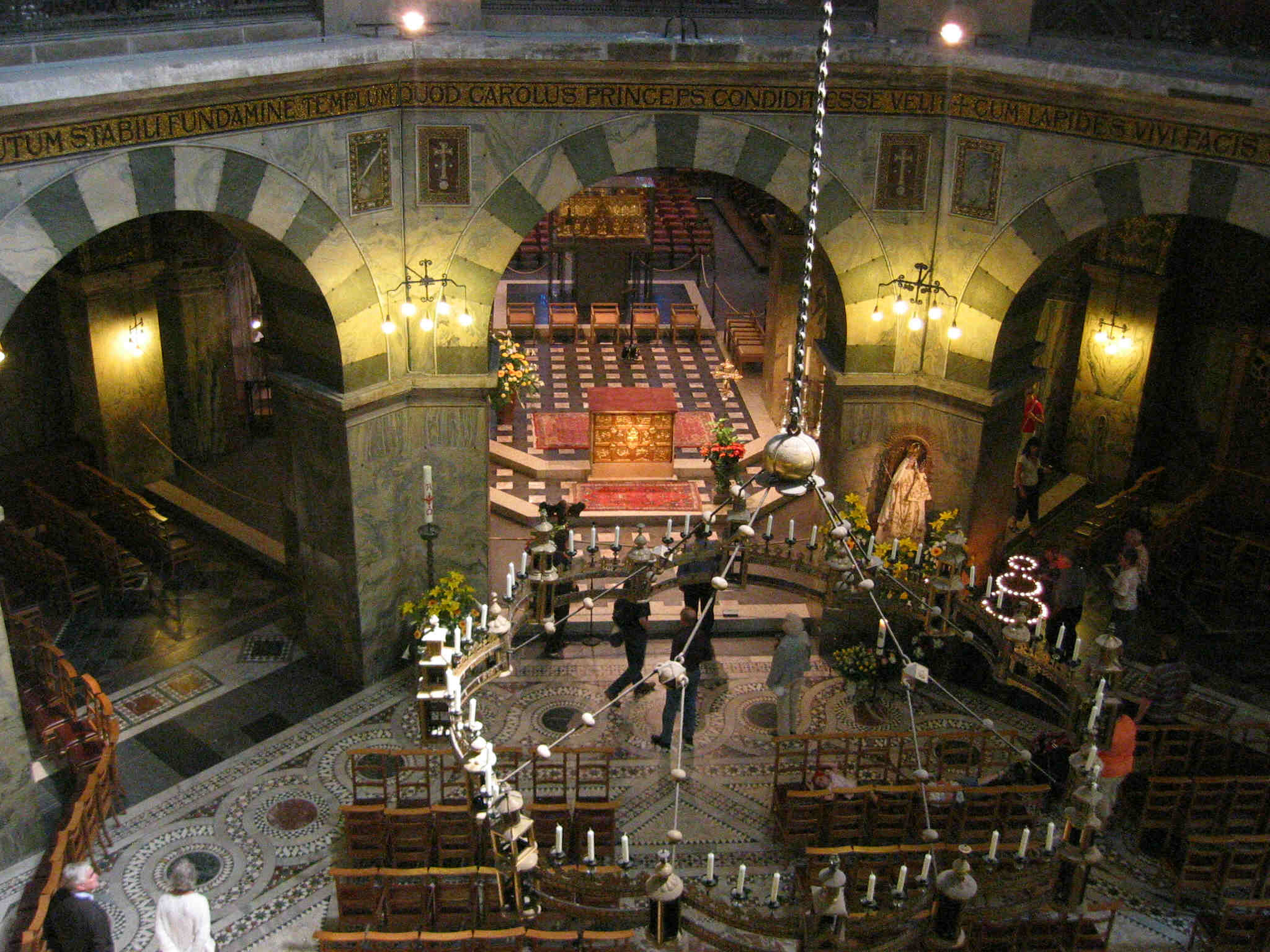
Frederick
I Barbarossa was crowned king in Aachen in 1152.
In 1165 he donated an amazing chandelier for 48 candles.
The diameter is 13.5 feet and matches the octagon.
Charlemagne
furnished the chapel with relics. In
799 a monk delivered a gift from the patriarch of Jerusalem which contain
Jesus’ swaddling clothes and loincloth, the garment Mary wore at the birth of
Jesus, and John the Baptist’s decapitation cloth. It was not until 1312 that
the relics were first displayed.
Charlemagne
died at age 72 on January 28, 814 and was buried in the octagon on the same day.
The exact spot is still unknown.
The
Gothic choir was built in 1355 for the large number of pilgrims.
It took 60 years to build. The
design was inspired by Sainte Chapelle in Paris.
In 1414, three days before the 600th anniversary of
Charlemagne’s death, the choir was consecrated.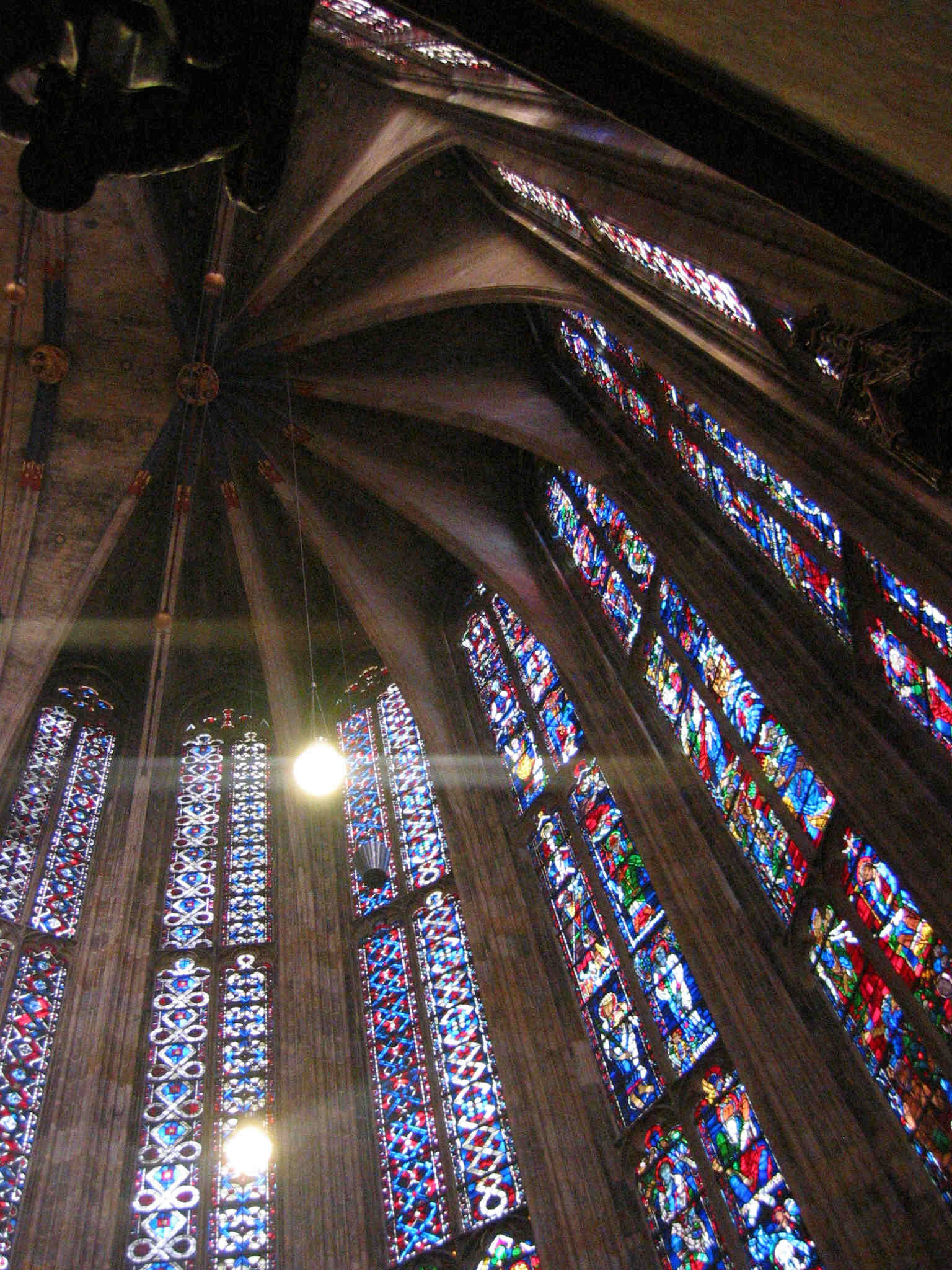
The
84 foot windows in the choir are the tallest north of the Alps.
In between the glass panels are 4.7 foot pillars.
There are no flying buttresses as in other Gothic structures.
Iron bands were drawn through the windows and pillars and then connected
to the existing structure. In 1729, hail destroyed the glass. The
present windows were completed in 1951.
In
the choir area there are two shrines – the Shrine of Mary and the Shrine of
Charlemagne.
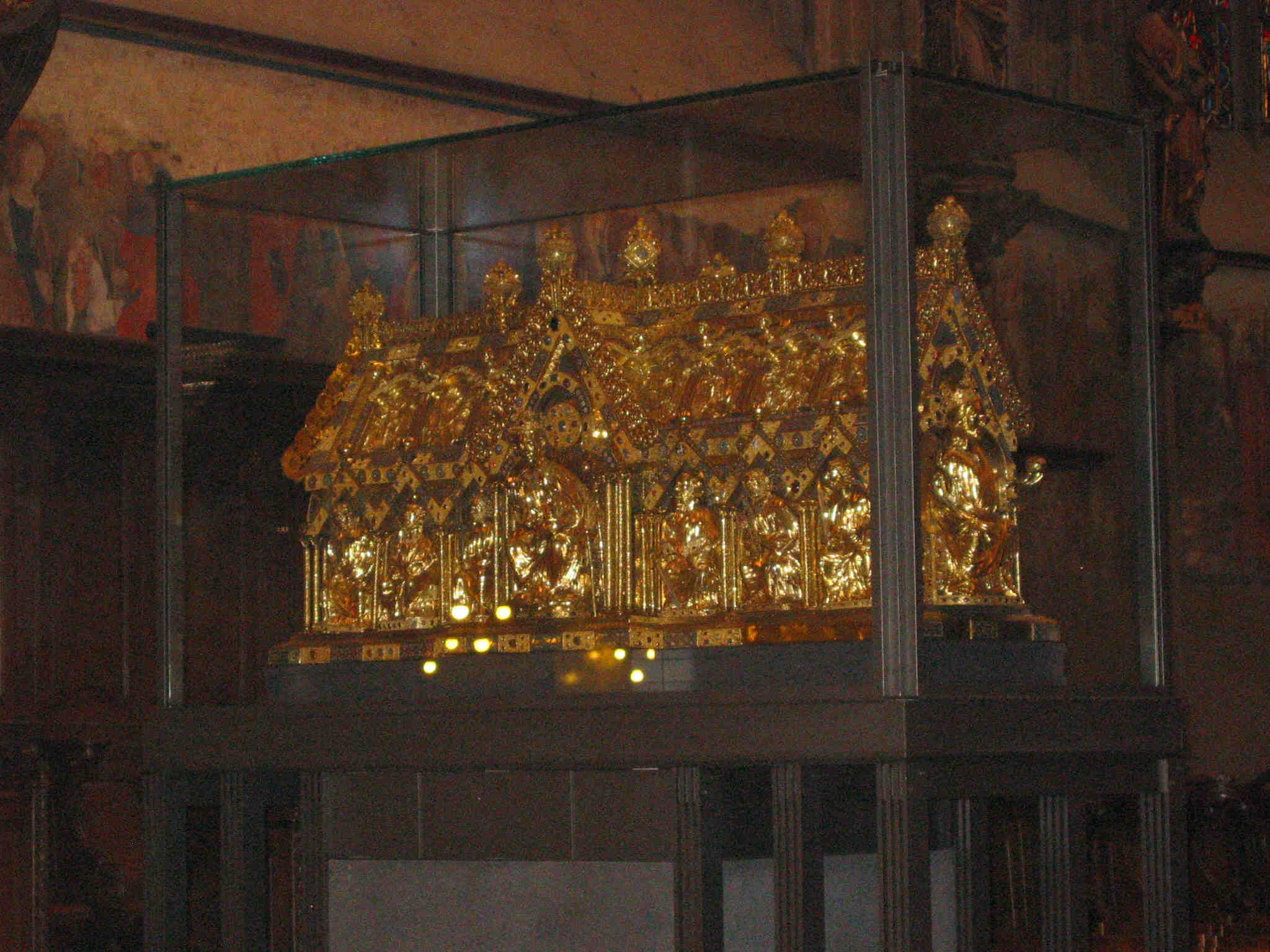
The
Shrine of Mary was designed in 1215 for the safekeeping of the original relics.
Thousands from all over Europe visited these shrines. On one day in 1496 there
were 142,000 pilgrims present. There
is a very unusual and interesting ceremony involved in viewing the relics.
The relics are placed in the shrine for 7 years.
The keyhole is sealed and the door of the shrine is lock with a new lock.
The key is broken in two and the town receives the ward end and the
cathedral chapter the handle. Seven
is the chosen number. The seventh
day of creation is the day of rest. Pilgrims
were shown the relics every 7 years at 7 places, 7 times a day in the 7th
month of the year, 7 days before and 7 days after the consecration celebration
of the church on July 17th.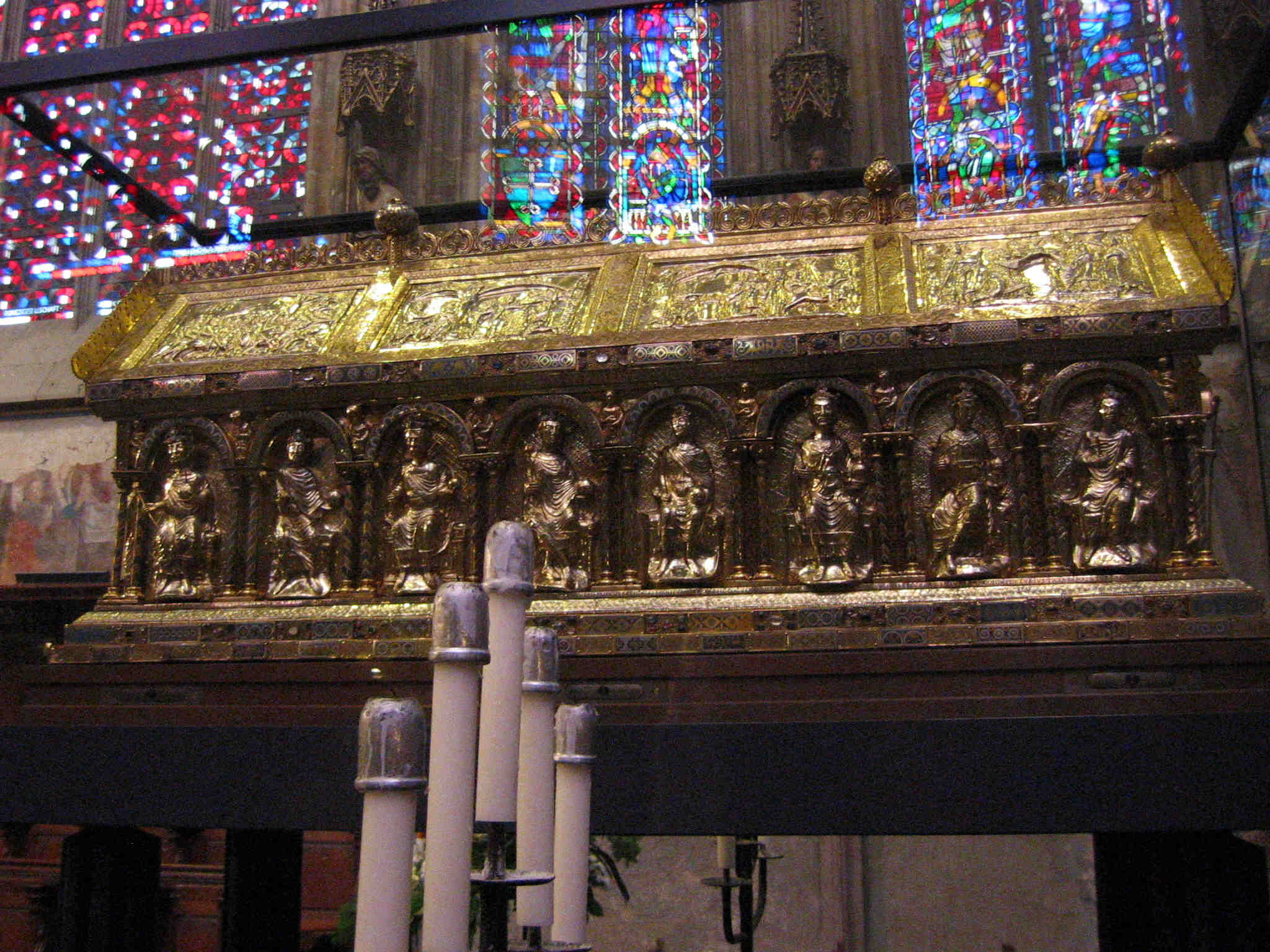
The
Shrine of Charlemagne was commissioned by Emperor Frederick Barbarossa in 1182
for Charlemagne’s remains. It was
completed in 1215. The inside is oak
and the outside is gilded silver. Contrary
to the other shrines of the same time period, Charlemagne’s shrine did not
show the twelve apostles. Instead
there are eight kings and eight emperors.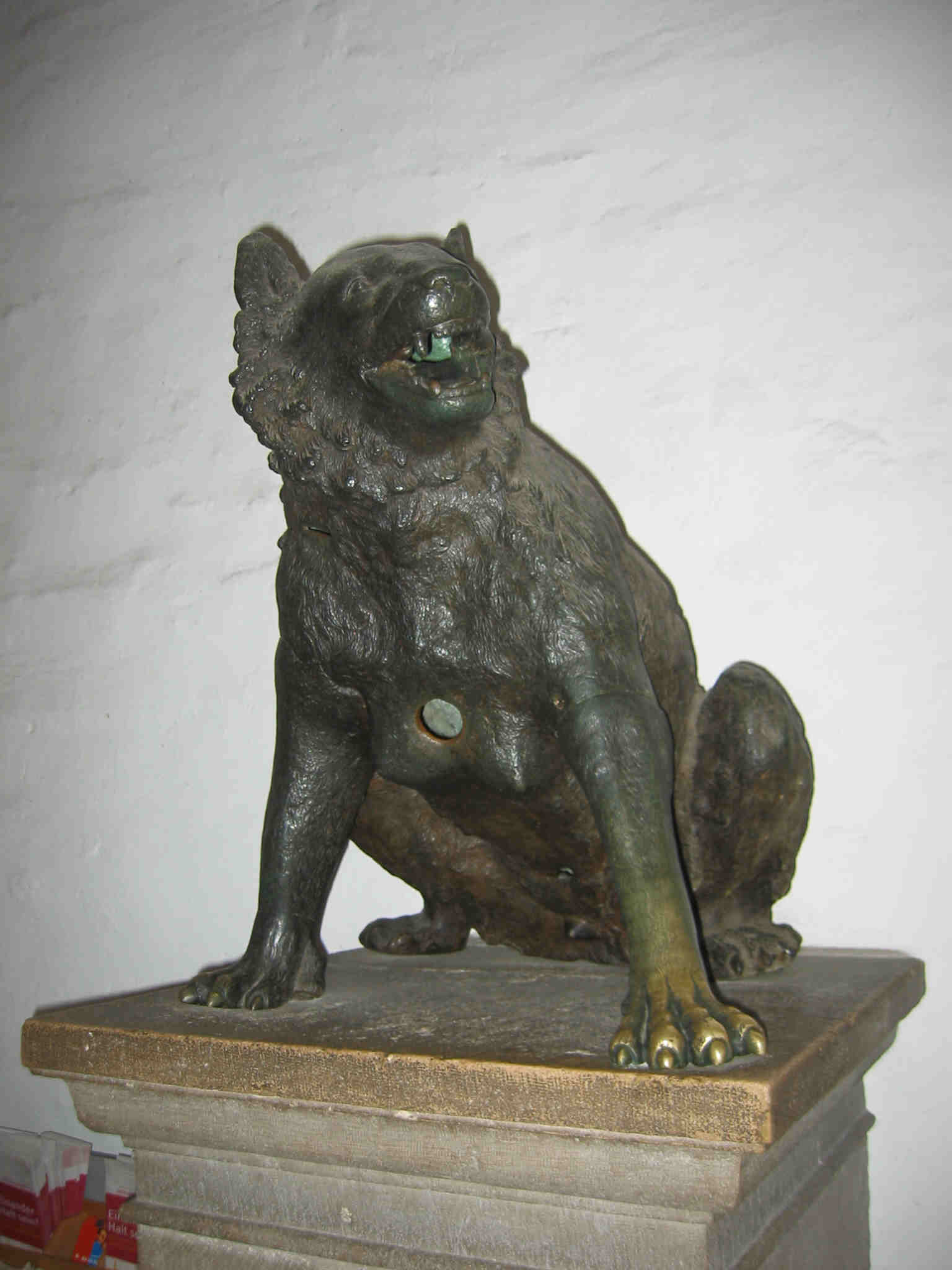
When
Charlemagne was building the cathedral, they ran out of money.
It is said that the devil made a deal with the town councilors that the
first person to enter the cathedral when it was completed would pay.
The town’s people send in a wolf first.
It was believed that the devil ripped out his heart – thus the whole in
his chest. The statue of the wolf
stands inside the front door.
We
saw a sign at the entrance to the cathedral that said we had to pay 2 € for a
“photo license”. Later, a man
approached me and charged me the 2€ for taking pictures.
I was not allowed to use my tripod.
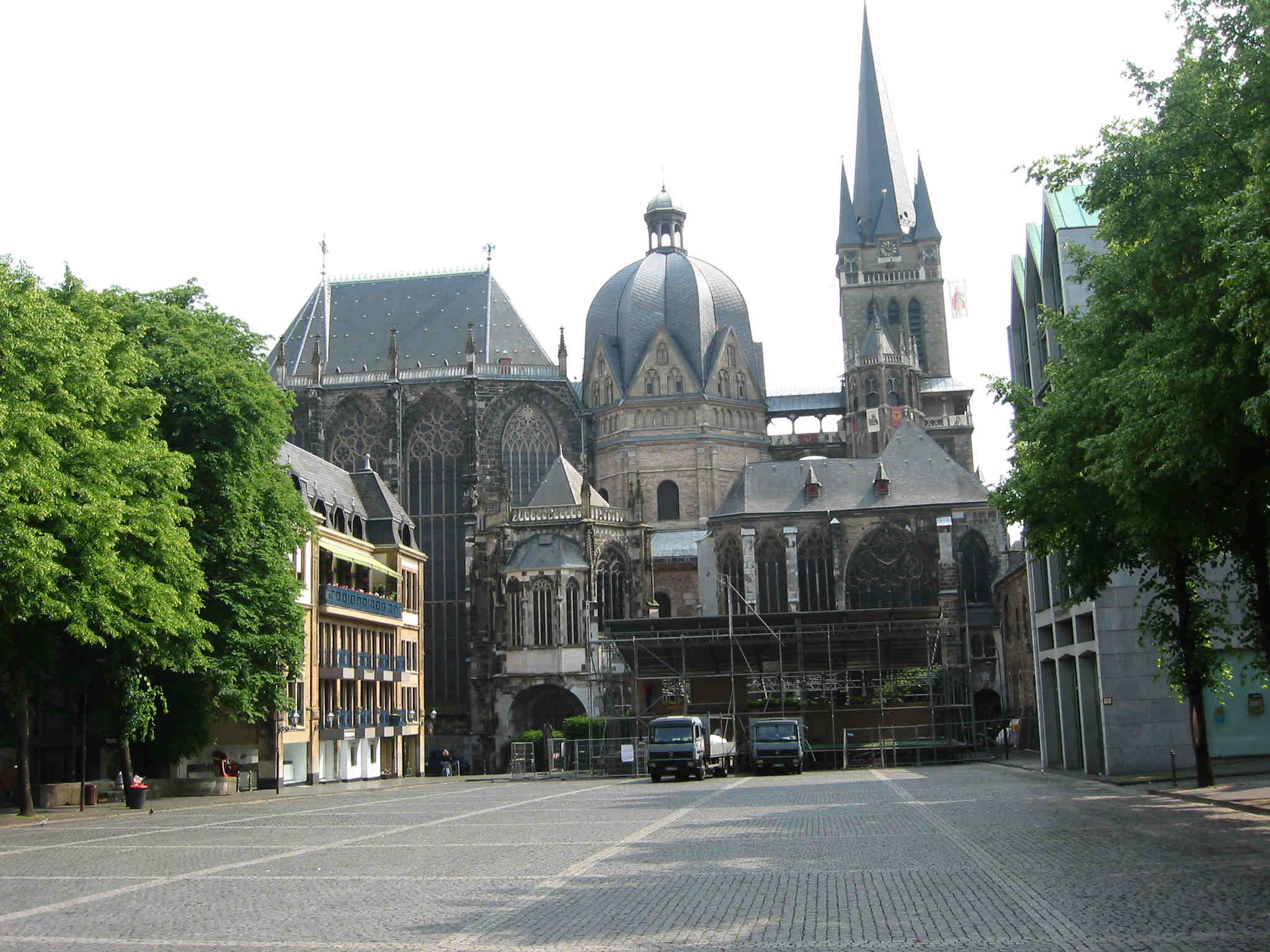
After
wandering around by ourselves for a while, we noticed that some people were
allowed in the choir where they could get a better few of the two shrines-
reliquaries. It seems these people
were on a tour. We found we could
take a tour in German at 1:00. We
went to a bookstore where we saw another model for me to build…see
AACHEN CATHEDRAL MODEL. We knew we didn’t have
time for lunch, so we hurried to find a restaurant where we could get something
to drink. We had lemonade at a bar
across from the cathedral. Even
though we could not understand a word that the guide was saying, we did get in
the choir and got a close up look at Mary and Charlemagne’s Shrine.
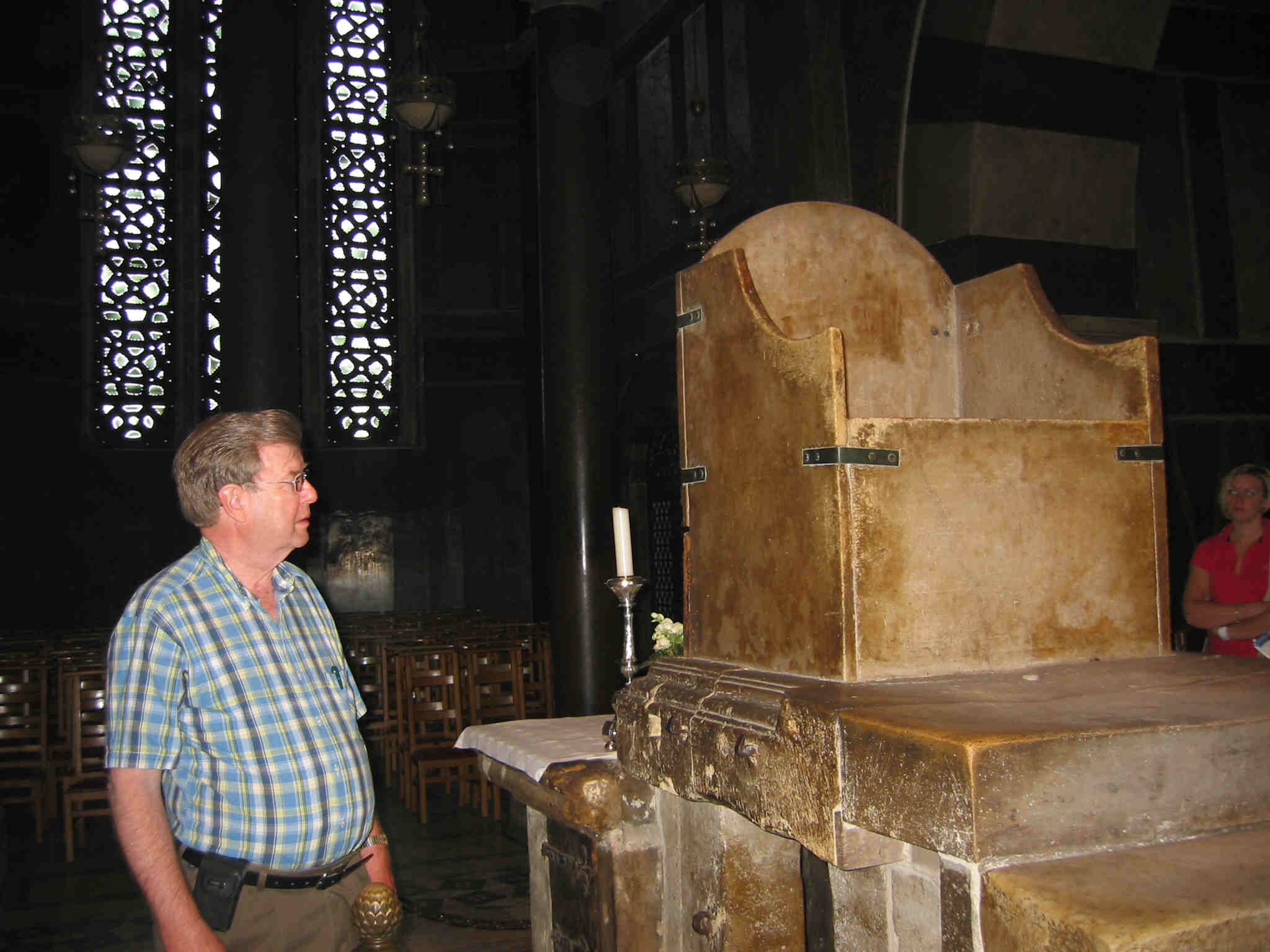
Then
we went upstairs to see Charlemagne’s throne. All
30 kings were crowded in Aachen Cathedral between 936 and 1531.
There are 6 steps leading up to it. They
represent the number of floors from the tower of Babylon.
It is designed of antique white marble slabs of different thickness, held
together by bronze clips. I really
wanted to sit on it but there was a rope around the entire area.
The
view down unto the floor of the old Carolingian church w as
outstanding. In addition to our
tour, there was a young lady giving an English tour so we listened to hear the
explanation of the throne.
When the tour was over, the guide speedily went down the steps while my
wife went slowing. She asked me to
hurry down the stairs to make sure the charming guide wouldn’t lock us in the
tower!! When we got to the bottom
the guide had closed the iron gate, and we couldn’t get out.
We keep asking for help (actually my wife yelled) and finally someone
came to our rescue and unlocked the door.
as
outstanding. In addition to our
tour, there was a young lady giving an English tour so we listened to hear the
explanation of the throne.
When the tour was over, the guide speedily went down the steps while my
wife went slowing. She asked me to
hurry down the stairs to make sure the charming guide wouldn’t lock us in the
tower!! When we got to the bottom
the guide had closed the iron gate, and we couldn’t get out.
We keep asking for help (actually my wife yelled) and finally someone
came to our rescue and unlocked the door.

We
had lunch back at the same café where we had our lemonade.
We sat outside. I had
Sauerbraten and my wife had a tuna salad. Both
were good. Then we went back to the
book store and got the
model and some post cards. They were 1€ each.
We walked around the outside of the church and found an ice cream store
and got a cone each. We sat in the
shade and relaxed.





The
84 foot windows in the choir are the tallest north of the Alps.
In between the glass panels are 4.7 foot pillars.
There are no flying buttresses as in other Gothic structures.
Iron bands were drawn through the windows and pillars and then connected
to the existing structure. In 1729, hail destroyed the glass. The
present windows were completed in 1951.
In
the choir area there are two shrines – the Shrine of Mary and the Shrine of
Charlemagne.

The
Shrine of Mary was designed in 1215 for the safekeeping of the original relics.
Thousands from all over Europe visited these shrines. On one day in 1496 there
were 142,000 pilgrims present. There
is a very unusual and interesting ceremony involved in viewing the relics.
The relics are placed in the shrine for 7 years.
The keyhole is sealed and the door of the shrine is lock with a new lock.
The key is broken in two and the town receives the ward end and the
cathedral chapter the handle. Seven
is the chosen number. The seventh
day of creation is the day of rest. Pilgrims
were shown the relics every 7 years at 7 places, 7 times a day in the 7th
month of the year, 7 days before and 7 days after the consecration celebration
of the church on July 17th.
The
Shrine of Charlemagne was commissioned by Emperor Frederick Barbarossa in 1182
for Charlemagne’s remains. It was
completed in 1215. The inside is oak
and the outside is gilded silver. Contrary
to the other shrines of the same time period, Charlemagne’s shrine did not
show the twelve apostles. Instead
there are eight kings and eight emperors.
When
Charlemagne was building the cathedral, they ran out of money.
It is said that the devil made a deal with the town councilors that the
first person to enter the cathedral when it was completed would pay.
The town’s people send in a wolf first.
It was believed that the devil ripped out his heart – thus the whole in
his chest. The statue of the wolf
stands inside the front door.
We
saw a sign at the entrance to the cathedral that said we had to pay 2 € for a
“photo license”. Later, a man
approached me and charged me the 2€ for taking pictures.
I was not allowed to use my tripod.

After
wandering around by ourselves for a while, we noticed that some people were
allowed in the choir where they could get a better few of the two shrines-
reliquaries. It seems these people
were on a tour. We found we could
take a tour in German at 1:00. We
went to a bookstore where we saw another model for me to build…see
AACHEN CATHEDRAL MODEL. We knew we didn’t have
time for lunch, so we hurried to find a restaurant where we could get something
to drink. We had lemonade at a bar
across from the cathedral. Even
though we could not understand a word that the guide was saying, we did get in
the choir and got a close up look at Mary and Charlemagne’s Shrine.

Then
we went upstairs to see Charlemagne’s throne. All
30 kings were crowded in Aachen Cathedral between 936 and 1531.
There are 6 steps leading up to it. They
represent the number of floors from the tower of Babylon.
It is designed of antique white marble slabs of different thickness, held
together by bronze clips. I really
wanted to sit on it but there was a rope around the entire area.
The
view down unto the floor of the old Carolingian church w as
outstanding. In addition to our
tour, there was a young lady giving an English tour so we listened to hear the
explanation of the throne.
When the tour was over, the guide speedily went down the steps while my
wife went slowing. She asked me to
hurry down the stairs to make sure the charming guide wouldn’t lock us in the
tower!! When we got to the bottom
the guide had closed the iron gate, and we couldn’t get out.
We keep asking for help (actually my wife yelled) and finally someone
came to our rescue and unlocked the door.
as
outstanding. In addition to our
tour, there was a young lady giving an English tour so we listened to hear the
explanation of the throne.
When the tour was over, the guide speedily went down the steps while my
wife went slowing. She asked me to
hurry down the stairs to make sure the charming guide wouldn’t lock us in the
tower!! When we got to the bottom
the guide had closed the iron gate, and we couldn’t get out.
We keep asking for help (actually my wife yelled) and finally someone
came to our rescue and unlocked the door.

We
had lunch back at the same café where we had our lemonade.
We sat outside. I had
Sauerbraten and my wife had a tuna salad. Both
were good. Then we went back to the
book store and got the
model and some post cards. They were 1€ each.
We walked around the outside of the church and found an ice cream store
and got a cone each. We sat in the
shade and relaxed.

When
Charlemagne was building the cathedral, they ran out of money.
It is said that the devil made a deal with the town councilors that the
first person to enter the cathedral when it was completed would pay.
The town’s people send in a wolf first.
It was believed that the devil ripped out his heart – thus the whole in
his chest. The statue of the wolf
stands inside the front door.
We
saw a sign at the entrance to the cathedral that said we had to pay 2 € for a
“photo license”. Later, a man
approached me and charged me the 2€ for taking pictures.
I was not allowed to use my tripod.

After
wandering around by ourselves for a while, we noticed that some people were
allowed in the choir where they could get a better few of the two shrines-
reliquaries. It seems these people
were on a tour. We found we could
take a tour in German at 1:00. We
went to a bookstore where we saw another model for me to build…see
AACHEN CATHEDRAL MODEL. We knew we didn’t have
time for lunch, so we hurried to find a restaurant where we could get something
to drink. We had lemonade at a bar
across from the cathedral. Even
though we could not understand a word that the guide was saying, we did get in
the choir and got a close up look at Mary and Charlemagne’s Shrine.

Then
we went upstairs to see Charlemagne’s throne. All
30 kings were crowded in Aachen Cathedral between 936 and 1531.
There are 6 steps leading up to it. They
represent the number of floors from the tower of Babylon.
It is designed of antique white marble slabs of different thickness, held
together by bronze clips. I really
wanted to sit on it but there was a rope around the entire area.
The
view down unto the floor of the old Carolingian church w as
outstanding. In addition to our
tour, there was a young lady giving an English tour so we listened to hear the
explanation of the throne.
When the tour was over, the guide speedily went down the steps while my
wife went slowing. She asked me to
hurry down the stairs to make sure the charming guide wouldn’t lock us in the
tower!! When we got to the bottom
the guide had closed the iron gate, and we couldn’t get out.
We keep asking for help (actually my wife yelled) and finally someone
came to our rescue and unlocked the door.
as
outstanding. In addition to our
tour, there was a young lady giving an English tour so we listened to hear the
explanation of the throne.
When the tour was over, the guide speedily went down the steps while my
wife went slowing. She asked me to
hurry down the stairs to make sure the charming guide wouldn’t lock us in the
tower!! When we got to the bottom
the guide had closed the iron gate, and we couldn’t get out.
We keep asking for help (actually my wife yelled) and finally someone
came to our rescue and unlocked the door.

We
had lunch back at the same café where we had our lemonade.
We sat outside. I had
Sauerbraten and my wife had a tuna salad. Both
were good. Then we went back to the
book store and got the
model and some post cards. They were 1€ each.
We walked around the outside of the church and found an ice cream store
and got a cone each. We sat in the
shade and relaxed.
Behind the apse of the Cathedral was another church, St. Folillan. The Cathedral was for the nobility. This was the parish church for the common people. The tower was in the back. Part of the church had been destroyed during the war so when they rebuilt it they left the right side(right photo) Romanesque and the left side is modern (left photo).
We
walked up a fe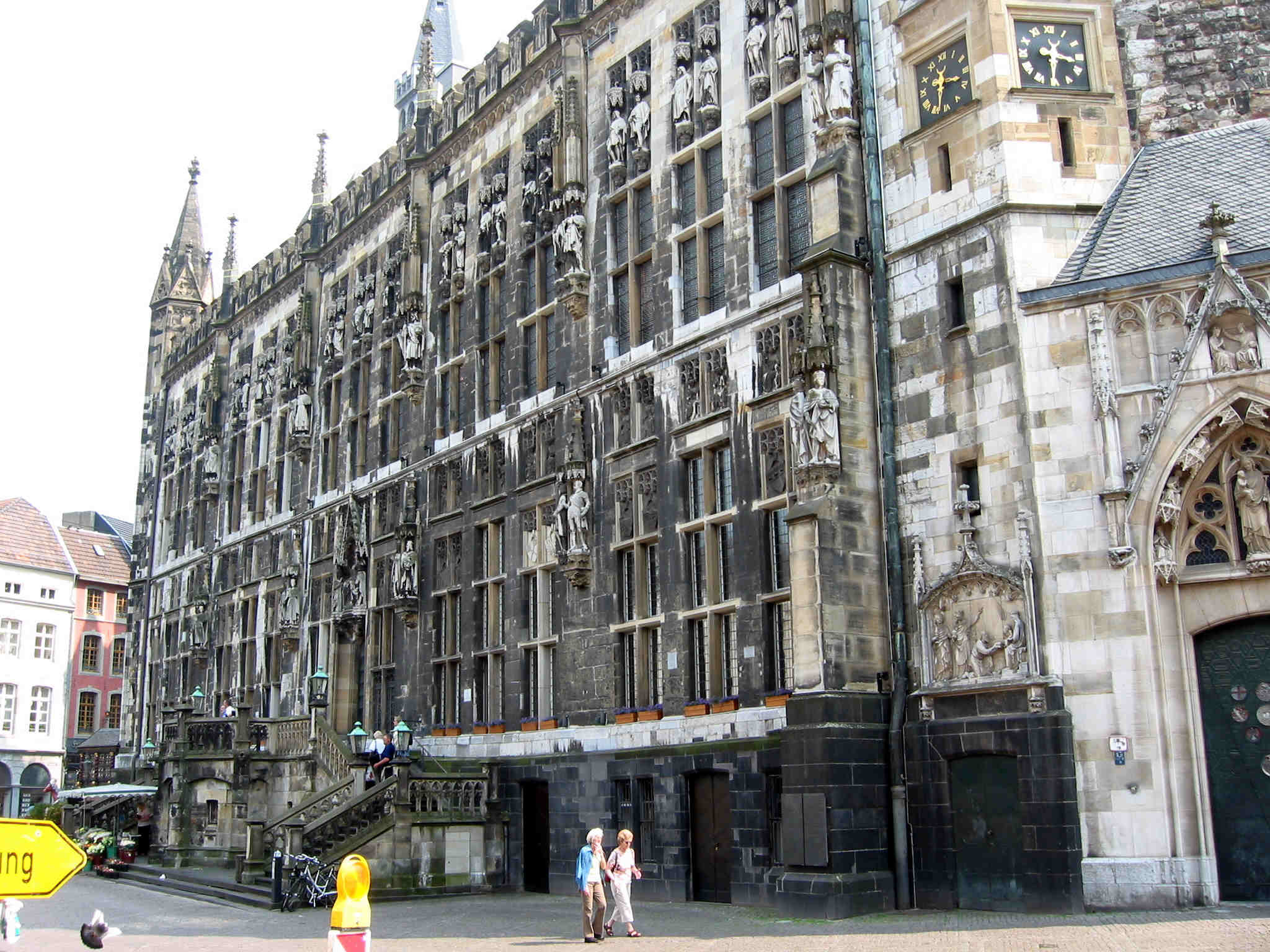 w
streets to the city hall which was an old palace.
We took a self-tour. The top
flo
w
streets to the city hall which was an old palace.
We took a self-tour. The top
flo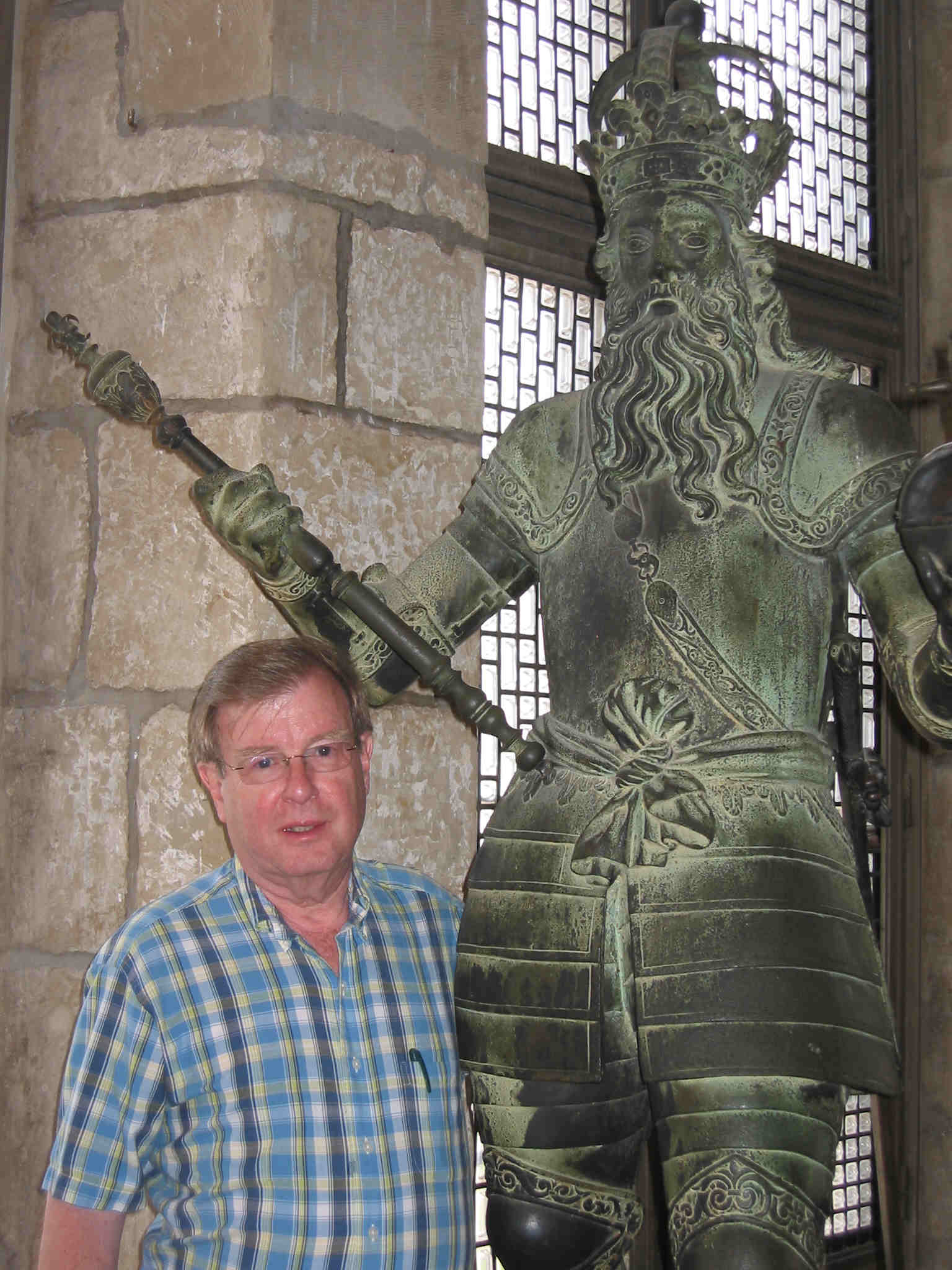 or
was a big conference room called “coronation hall” with murals about Charlemagne.
or
was a big conference room called “coronation hall” with murals about Charlemagne.
It
was long walk back
to the train station, and we were not sure of the way. We kept following signs
for the HBH (train station). We were
tired. We had a hard time
figuring out the train because the train before ours was 40 minutes late.
We did get on the right train…first class again.
We got off at the Koln Hbf and
went to our hotel for a little Jim Beam. Then
out to look at the cathedral again. There
was a Mass in one of the chapels so we attended.
There weren’t any guards or spies around so we took communion.
We
looked for a restaurant that was listed our one of our books but it wasn’t
there anymore. We went to the
tourist bureau and bought a large poster print of the Cathedral for 1€ and a
mail tube for .60€. We looked
around for a place to eat. This
search for a restaurant took us through some lovely streets with up-scale shops
that we hadn’t seen before. It
seemed that all the restaurants were full.
It appears that everyone
spends a lot of time drinking as it was about 7:30 and couldn’t see
anyone eating. We found a nice
outdoor café, Hof 18. My wife had
Haehnchenbrust ( spicy chicken breast ) and I had Lammfiletspiess (lamb and
shrimp on a skewer). The restaurant
faced the west side of the cathedral. It
reminded us of having dinner facing Chartres.
The dinner was good but the wait was very long.
Went
back to hotel and packed our bags.
Next Day
Day 1 - Cologne
Day 2 - Cologne
Day 3 -Aachen
Day 4 - Maria Laach - Mainz
Day 5 - Mainz
to Trier
Day 6 - Trier
Day -7- Speyer
Day 8 - Speyer - Strasbourg - Freiburg
Day 9 - Basel - Lindau
Day 10 - Lindau- Meersburg
Day 11 - Lindau
Day 12 -
Hohenschwangau
Day 13 - Zurich
Day 14 - Zurich -home
Home

